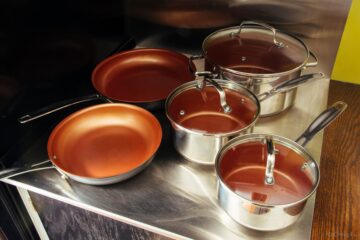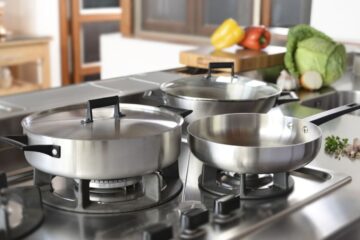Parini cookware is a popular choice for many home cooks due to its durability and versatility. However, some people may be unsure of how to properly use this type of cookware to get the best results. In this article, we will provide a comprehensive guide on how to use Parini cookware effectively.
Whether you’re a beginner or an experienced cook, it’s essential to understand the basics of using Parini cookware. From selecting the right pot or pan to properly preheating your oven, we’ll cover all the essential steps to help you achieve delicious and healthy meals. By following our guide, you’ll be able to make the most out of your Parini cookware and enjoy cooking with confidence.
Understanding Parini Cookware
Parini cookware is known for its bright colors and unique marble-coated design inspired by Middle Eastern and European styles. It is a popular choice for many home cooks due to its non-stick surface that requires less oil for cooking and even heat distribution. In this section, we will explore the materials used in Parini cookware, the different types available, and its notable features.
Materials Used in Parini Cookware
Parini cookware is made from high-quality materials that ensure durability and longevity. The pots and pans are made with a heavy-gauge aluminum base that provides even heat distribution and prevents hot spots. The non-stick coating is made with a PFOA-free marble-like material that is scratch-resistant and easy to clean. The handles are made with silicone or stainless steel, which is heat-resistant and provides a comfortable grip.
Types of Parini Cookware
Parini cookware comes in a variety of types to suit different cooking needs. Some popular types include:
- Fry pans: Available in different sizes, these pans are ideal for frying, sautéing, and searing.
- Saucepan: This type of cookware is perfect for making sauces, soups, and stews.
- Stockpot: Ideal for cooking large quantities of food, such as pasta, chili, and soup.
- Casserole dish: This type of cookware is perfect for baking casseroles, lasagnas, and other oven-baked dishes.
- Griddle: Ideal for cooking pancakes, eggs, and other breakfast foods.
Features of Parini Cookware
Parini cookware has several features that make it a popular choice among home cooks. Some notable features include:
- Non-stick surface: The non-stick coating ensures that food does not stick to the surface, making it easy to clean and reducing the need for oil.
- Even heat distribution: The heavy-gauge aluminum base ensures that heat is evenly distributed, preventing hot spots and ensuring that food cooks evenly.
- Scratch-resistant: The marble-like coating is scratch-resistant, ensuring that the cookware remains in good condition for longer.
- Oven-safe: Parini cookware is oven-safe, allowing you to cook and bake a variety of dishes in the same pot or pan.
- Dishwasher-safe: Most Parini cookware is dishwasher-safe, making it easy to clean and maintain.
Preparing Parini Cookware for Use
Before using Parini cookware, it is important to prepare it properly to ensure that it lasts long and performs well. This section will cover the two main steps in preparing Parini cookware for use: washing and seasoning.
Washing Parini Cookware
To wash Parini cookware, it is recommended to use mild soap and warm water. Avoid using abrasive sponges or harsh chemicals as they can damage the surface of the cookware. After washing, rinse the cookware thoroughly with clean water and dry it with a soft cloth or towel.
Parini cookware is also dishwasher safe, but it is important to use the low setting to prevent damage to the surface. It is recommended to wash the cookware by hand to ensure that it is properly cleaned.
Seasoning Parini Cookware
Seasoning Parini cookware is an important step to prevent food from sticking to the surface and to improve its non-stick properties. To season the cookware, follow these steps:
- Preheat the oven to 350°F.
- Apply a thin layer of vegetable oil to the surface of the cookware using a paper towel or brush.
- Place the cookware in the oven and bake for 30 minutes.
- Let the cookware cool down before wiping off any excess oil.
It is recommended to repeat this process every few months to maintain the non-stick properties of the cookware.
Using Parini Cookware
Parini cookware is a popular choice for many home cooks due to its durability and versatility. Here are some tips on how to use and care for your Parini cookware to ensure it lasts for many years.
Cooking with Parini Cookware
When cooking with Parini cookware, it is important to use the correct utensils to prevent scratching or damaging the non-stick surface. Wooden or silicone utensils are recommended.
To cook on the stovetop, preheat the pan on medium heat for 2-3 minutes before adding any oil or food. This will help to evenly distribute heat and prevent food from sticking.
When using Parini cookware in the oven, preheat the oven to the recommended temperature for the recipe. Place the cookware in the center of the oven to ensure even cooking.
Cleaning Parini Cookware
To clean Parini cookware, it is recommended to wash it by hand with warm water and mild dish soap. Avoid using abrasive sponges or cleaners that can scratch the non-stick surface.
If food is stuck to the cookware, fill it with warm water and let it soak for 15-20 minutes before washing.
Avoid using metal utensils or stacking the cookware to prevent scratches or damage.
One of the most important things to keep in mind when using Parini cookware is to maintain the right temperature. It is not suitable for high-heat cooking, as its layers or coatings may peel off if you use it on a high flame. Instead, it is essential to cook the meal on low to medium flame to ensure that the cookware performs optimally. Additionally, it is crucial to follow the manufacturer’s instructions for preheating the cookware before use to ensure even cooking and prevent food from sticking to the surface.
Another important aspect of using Parini cookware is proper cleaning and maintenance. To keep it in good condition, it is important to clean it after every use and avoid using abrasive materials that can scratch or damage the surface. Additionally, it is recommended to use low settings when washing it in a dishwasher, or better yet, wash it by hand to ensure that it lasts longer and performs better.
Maintaining Parini Cookware
Parini cookware is a great addition to any kitchen. It is easy to use and maintain, but proper care is essential to ensure it lasts for a long time. This section will provide some tips on how to maintain your Parini cookware.
Storing Parini Cookware
When storing Parini cookware, it is important to keep it in a cool and dark place. Bright light can affect the metal’s color and make it fade quickly. Furthermore, storing them in extreme temperatures can also affect the quality of the material used to manufacture the pots. Therefore, it is best to avoid storing them in places like the attic or the basement.
To prevent scratches and other damage to the surface of your Parini cookware, it is best to stack them carefully. You can use a soft cloth or paper towel to separate them. Another option is to hang them using hooks or a pot rack. This not only keeps them organized but also prevents them from getting damaged.
Troubleshooting Parini Cookware
If you notice that your Parini cookware is not performing as it should, there are a few things you can do to troubleshoot the problem. Here are some common issues and their solutions:
- Sticking food: If your food is sticking to the surface of your Parini cookware, it may be because the surface is damaged or scratched. In this case, it is best to replace the pot or pan. However, if the surface is still intact, you may need to adjust the heat. Parini cookware requires less heat than other cookware, so try lowering the temperature.
- Discoloration: If you notice that your Parini cookware is losing its color, it may be because of high heat. Parini cookware is not designed to withstand high temperatures, so it is best to keep the heat low or average. Additionally, avoid using metal utensils, as they can scratch the surface and cause discoloration.
- Cleaning: To keep your Parini cookware looking its best, it is important to clean it regularly. Use a non-abrasive cleaner and a soft scrubber to remove any stuck-on food or stains. Avoid using harsh chemicals or metal scrubs, as they can damage the surface. If you have burnt-on food, you can soak the cookware in warm soapy water to loosen it.
Conclusion
In conclusion, using Parini cookware is a simple and easy process that can help you create delicious and healthy meals in your kitchen. By following the manufacturer’s instructions and taking the necessary precautions, you can ensure that your cookware lasts for years to come.
Some key takeaways from this guide include properly cleaning your Parini cookware after each use, avoiding the use of non-stick covers, and preheating your oven to the recommended temperature before cooking. Additionally, it is important to avoid overcrowding the pan and to use medium to low heat while cooking to prevent damage to the material.
Overall, Parini cookware is a great investment for any home cook looking to elevate their cooking game. With its high-quality materials and durable construction, it is sure to provide you with many delicious meals for years to come.



